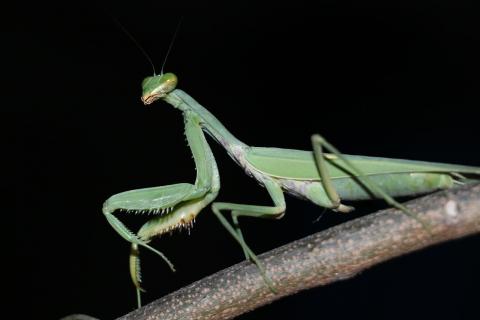Should I Release Praying Mantis into My Garden?

When gardeners think of natural pest control, praying mantids often come to mind. Note that ‘mantid’ is a more accurate term than ‘mantis’, as only some praying mantids belong to the genus Mantis. Mantid refers to all members of the insect group. Mantids are predators that actively search for their prey visually. They lie in wait until an insect moves into their vicinity, ambushing it and capturing it with their front legs. Sharp spines on the insides of the legs pierce prey and hold it in place while the mantid eats it. Mantids feed on a variety of insects, including other mantids.
Only one species of praying mantid is typically found in New Hampshire, the European mantid (Mantis religiosa). This species is native to Europe and was most likely introduced by gardeners on purpose and has since become widespread. Though they do not occur in New Hampshire, two other species are common in North America: the non-native Chinese mantid (Tenodera sinensis) and Carolina mantid (Stagmomantis carolina).
Is it worthwhile to purchase and release praying mantids into the garden? Probably not. Despite being voracious and deadly predators, praying mantids are not entirely beneficial insects. They are just as likely to eat a butterfly or bumblebee as they are a nuisance caterpillar, making them a neutral factor in the garden, if anything. They also prey on each other, so they are unlikely to become terribly abundant in the landscape even if they are released. You cannot count on them to stay where you want them and so may have little affect on a particular pest issue. Praying mantids are not native to New Hampshire, which brings into question whether they should be released.
Ultimately, you are probably better off saving your money and doing what you can to promote native beneficial insects on your property instead of buying mantids. Native good guys include natural enemies like lacewings, assassin bugs and tachinid flies, as well as pollinators. Outside of avoiding insecticides, increasing the diversity of your landscape is important. Grow a wide variety of different plants to host many different species of beneficials. Also, planting the right plant in the right place based on growing conditions and plant needs will make plants more resistant to pests. Providing some shelter for nesting and resting is also critical, in the form of undisturbed bare soil, leaf debris, decaying wood, and dead stems. Finally, accept that some insect damage is okay. Most plants can suffer a fair amount of pest damage without ill effects.
Do you love learning about stuff like this?
SUBSCRIBE TO GRANITE STATE GARDENING
A monthly newsletter for New Hampshire gardeners, homesteaders and plant-lovers of all kinds, that includes seasonal suggested gardening tips, upcoming events and articles with proven solutions for your garden and landscape.
Got questions? The UNH Extension Infoline offers practical help finding answers for your home, yard, and garden questions. Call toll free at 1-877-398-4769, Monday to Friday, 9 a.m. to 2 p.m., or e-mail us at answers@unh.edu.
